Complete Solutions to Numerical MCQs Single Options Correct of chapter HEAT TRANSFER of Class 12 book with complete answers and questions
| Class 12 | PHYSICS |
| Chapter | HEAT TRANSFER |
| PHYSICS GALAXY | Numerical MCQs Single Options Correct |
| Number Of Questions | 94 |
| Academic Year | 2023-24 |
Two spheres of radii `R_(1)` and `R_(2)` are made of the same material and are at the same temperature. The ratio of their thermal capacities is:
04:24View SolutionTwo different metal rods of equal lengths and equal areas of cross-section have their ends kept at the same temperature `theta_(1)` and `theta_(2)`. if `K_(1)` and `K_(2)` are their thermal conductivities, `rho_(1)` and `rho_(2)` their densities and `S_(1)` and `S_(2)` their specific heats, then the rate of flow of heat in the two rods will be the same if:
05:07View SolutionA slab of stone of area `0.34 m ^(2)`and thickness 10 cm is exposed on the lower face to steam at `100^(@)C`.A block of ice at `0^(@)C` rests on the upper face of the slab. In one hour, 3.6 kg of ice is melted. Assume that the heat loss from the sides is negligible. The latent heat of fusion of ice is `3.4 xx 10^(4) J kg^(-1)`. What is the thermal conductivity of the stone in units of `Js^(-1) m^(-1)``""^(@)C^(-1)` ?
06:25View SolutionThe top of a lake is frozen as the atmospheric temperature is `-10^(@)C`. The temperature at the bottom of the lake is most likely to be,
02:06View SolutionThe tungsten filament of an electric lamp has a surface areaA and a power rating P. If the emissivity of the filament is `varepsilon` and `sigma` is Stefan's constant,the steady temperature of the filament will be:
02:14View SolutionWhat are the dimensions of Stefan's constant ?
02:05View SolutionTwo uniform brass rods A and B of lengths l and 2l and radii 2r and r respectively are heated to the same temperature. The ratio of the increase in the length of A to that of B is :
03:58View SolutionA slab consists of two parallel layers of two different materials of same thickness having thermal conductivities `K_(1) and K_(2)`. The equivalent conductivity of the combination is
01:59View SolutionThe amount of heat conducted out per second through a window, when inside temperature is `10^(@)C` and outside temperature is `-10^(@)C`, is 1000 J. Same heat will be conducted in through the window, when outside temperature is `-23^(@)C` and inside temperature is:
05:38View SolutionA composite slab consists of two slabs A and B of different materials but of the same thickness placed one on top of the other. The thermal conductivities of A and B are `k_(1)` and `K_(2)` respectively. A steady temperature difference of `12^(@)C` is maintained across the composite slab. If `k_(1) = K_(2)//2`, the temperature difference across slab A will be:
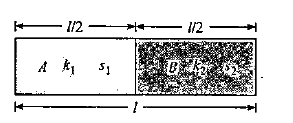 09:24View Solution
09:24View SolutionTwo rods of equal length and diameter but of thermal conductivities 2 and 3 unites respectively are joined in parallel. The thermal conductivity of the combination is:
05:38View SolutionIf the coefficient of conductivity of aluminium is `0.5 cal cm^(-1) s^(-1).^(@)C^(-1)`, then the other to conductor `10 cal s^(-1) cm^(-2)` in the steady state, the temperature gradient in aluminium must be
02:19View SolutionWien's constant is `2892 xx10^(-6)` SI unit and the value of `lambda_(m)` for Moon is 14.46 micron.The surfece temperature of Moon is :
03:17View SolutionThe coefficient of thermal conductivity of copper, mercury and glass are respectively `K_(c), K_(m)` and `K_(g)` that `K_(c) gt K_(m) gt K_(g)`. If the same quantity of heat is to flow per second per unit of each and corresponding temperature gradients are `X_(c), X_(m)` and `X_(g)`, then
02:17View SolutionTwo cylindrical rods of lengths `l_(1)` and `l_(2)`, radii `r_(1)` and `r_(2)` have thermal conductivities `k_(1)` and `k_(2)` respectively. The ends of the rods are maintained at the same temperature difference. If `l_(1) =2l_(2)` and `r_(1) =r_(2)//2`, the rates of heat flow in them will be the same if `k_(1)//k_(2)` is:
05:40View SolutionThe amount of thermal radiations emitted from one square centimetre area of a black body in one second when at a temperature of 1000 K is:
03:39View SolutionIf temperature of a black body increases from `7^(@)C` to `287^(@)C` , then the rate of energy radiation increases by
02:42View SolutionA body cools from `60^(@)C` to `50^(@)C` in 10 minutes . If the room temperature is `25^(@)C` and assuming Newton's law of cooling to hold good, the temperature of the body at the end of the next 10 minutes will be
03:05View SolutionGiven that p joule of heat is incident on a body and out of it q joule is reflected and transmitted by it. The absorption co-efficient of the body is :
04:07View SolutionA black body radiates 3 joule per square centimeter per second when its temperature is `127^(@)C`.How much heat will be radiated per square centimetre per second when its temperature is `527^(@)C`?
04:05View SolutionThe rate of loss of heat by radiation from a body at `400^(@)C` is R. The radiation from it when the temperature rises to `800^(@)C` ?
03:22View SolutionTwo rods of the same length and material transfer a given amount of heat in 12 seconds when they are joined end to end. But when they are joined lengthwise, they will transfer the same amount of heat, in the same conduction, in :
04:16View SolutionA body cools from `50.0^(@)C` to` 49.9^(@)C` in 5s. How long will it take to cool from `40.0^(@)C` to `39.9^(@)C` ? Assume the temperature of the surroundings to be `30.0^(@)C` and Newton's law of cooling to be valid:
05:58View SolutionRadiation from a black body at the thermodynamic temperature `T_(1)` is measured by a small detector at distance `d_(1)` from it. When the temperature is increased to `T_(2)` and the distance to `d_(2)` , the power received by the detector is unchanged. What is the ratio `d_(2)//d_(1)`?
03:54View SolutionTwo bars of equal length and the same cross-sectional area but of different thermal conductivities,` k_(1)` and `k_(2)`, are joined end to end as shown in figure-4.36. One end of the composite bar is maintained at temperature `T_(h)` whereas the opposite end is held at `T_(c)`.
If there are no heat losses from the sides of the bars, the temperature `T_(j)` of the junction is given by :
 05:37View Solution
05:37View SolutionA composite slab consists of two parts of equal thickness. The thermal conductivity of one is twice that of the other. What will be the ratio of temperature difference across the two layers in the state of equilibrium ?
02:40View SolutionThe room temperature is 20''C. Water in a container cools from `55^(@)C` to `45^(@)C` in 8 minutes. How much time will it take in cooling from `45^(@)C` to `35^(@)c` ?
02:11View SolutionWhen the temperature difference between inside and outside of a room is `20^(@)C`,the rate of heat flow through a window is `273 Js^(-1)`. If the temperature difference becomes 20K, the rate of flow of heat through the same window will be:
02:37View SolutionA wall has two layers A and B, each made of different materials. Both layers are of same thickness. But, the thermal conductivity of material A is twice that of B. If, in the steady state, the temperature difference across the wall is `24^(@)C`, then the temperature difference across the layer B is :
05:23View SolutionYou are given two spheres of same material and radii 10 cm and 20 cm. They are heated to the same temperature. They are placed in the same environment. The ratio of their rates of cooling will be:
View SolutionAn object is cooled from `75^(@)C` to `65^(@)C` in 2 min in a room at `30^(@)C`. The time taken to cool the same object from `55^(@)C` to `45^(@)C` in the same room is
01:27View SolutionThe temperature of a room heated by heater is `20^@C` when outside temperature is `-20^@C` and it is `10^@C` when the outside temperature is `-40^@C`. The temperature of the heater is
03:45View SolutionThe thermal conductivity of two materials are in the ratio 1 : 2. What will be the ratio of thermal resistances of rods of these materials having length in the ratio 1 :2 and area of cross-section in the ratio 1:2 :
02:30View SolutionTwo rods made of same material having same length and diameter are joined in series. The thermal power dissipated through then is 2W.If they are joined in parallel, the thermal power dissipated under the same conditions on the two ends of the rods, will be :
03:51View SolutionThe maximum radiations from two bodies correspond to 560 nm and 420 nm respectively. The ratio of their temperature is:
01:22View SolutionA ball is coated with lamp black. Its temperature is `327^(@)C` and is placed in the atmosphere at `27^(@)C`. Let the rate of cooling be R. If the temperature of the ball be `627^(@)C`, what will be its rate of cooling ?
02:30View SolutionTwo metallic rods are connected in series. Both are of same material of same length and same area of cross-section. If the conductivity of each rod be k, then what will be the conductivity of the combination ?
02:39View SolutionA compound slab is made of two parallel plates of copper and brass of the same thickness and having thermal conductivities in the ratio `4:1`. The free face of copper is at `0^(@)C`. The temperature of the internal is `20^(@)C`. What is the temperature of the free face of brass?
04:10View SolutionConsider the two insulating sheets with thermal resistance `R_(1)` and `R_(2)` as shown in figure. The temperature `theta` is
 01:56View Solution
01:56View SolutionTwo cylindrical rods of same meterial have the same temperature difference between their ends. The ratio of rates of flow of heat through them is 1 : 8. The ratio of the radii of the rods are 1 : 2. What is the ratio of their lengths ?
02:11View SolutionAn object is at temperature of `400^(@)C`. At what approximate temperature would it radiate energy twice as first ? The temperature of surroundings may be assumed to be negligible:
02:51View SolutionA wall has two layers A and B, each made of different material. Both the layers have the same thickness. The thermal conductivity of the material of A is twice that of B . Under thermal equilibrium, the temperature difference across the wall is `36^@C.` The temperature difference across the layer A is
04:16View SolutionThe ratio of the coefficient of thermal conductivity of two different materials is `5 : 3`. If the thermal resistance of the rod of same thickness resistance of the rods of same thickness of these materials is same, then the ratio of the length of these rods will be
02:40View SolutionA cylindrical rod with one end in a steam chamber and the other end in ice results in melting of 0.1 g of ice per second. If the rod is replaced by another rod with half the length and double the radius of the first and if the thermal conductivity of material of the second rod is 0.25 times that of first, the rate at which ice melts in `gs^(-1)` will be:
03:07View SolutionThere is ice formation on a tank of water of thickness 10 cm.How much time it will take to have a layer of 0.1 cm below it ?The outer temperature is `-5^(@)C`, the thermal conductivity of ice is ` 0.005 calcm^(-1)``""^(@)C^(-1)` and latent heat of ice is `80cal//g` and the density of ice is `0.91 gcm^(-3)`:
05:00View SolutionThe rectangular surface of area `8 cm xx 4 cm` of a black body at temperature `127^(@)C` emits energy `E` per section if length and breadth are reduced to half of the initial value and the temperature is raised to `327^(@)C`, the ratio of emission of energy becomes
01:46View SolutionThe emissivity and surface area of tungsten filament of an electric bulb are 0.35 and `0.25 xx 10^(-4) metre^(2)` respectively. The operating temperature of filament is 3000 K. If`sigma = 5.67 xx 10^(-8) watt melre^(-2) K^(-4)`, then power of bulb is approximately:
03:27View SolutionIce starts forming in lake with water at `0^(@)C` and when the atmospheric temperature is `-10^(@)C`. If the time taken for `1 cm` of ice be `7` hours. Find the time taken for the thickness of ice to change from `1 cm` to `2 cm`
09:24View SolutionWhich of the following cylindrical rods of the same metal has the highest rate of flow of heat ? The rods have equal difference of temperature between their ends :
02:38View SolutionIn Q.No.4-49, the lowest rate of flow of heat is for:
02:38View SolutionThree rods made of same material and having the same cross-section have been joined as shown. In the figure.Each rod is of the same length. The left and right ends are kept at `0^@C and 90^@C` respectively. The temperature of the junction of the three rods will be
 03:20View Solution
03:20View SolutionThe intensity of radiation emitted by the sun has its maximum value at a wavelength of 510 nm and that emitted by the North star has the maximum value at 350 nm. If these stars behave like black bodies, then the ratio of the surface temperatures of the sun and the north star is
01:45View SolutionTwo different metal rods of the same length have their ends kept at the same temperature `theta_(1)`, and `theta_(2)`with `theta_(2) gt theta_(1)`. If `A_(1)` and `A_(2)` are their cross-sectional areas and `K_(1)` and `K_(2)` their thermal conductivities, the rate of flow of heat in the two rods will be the same it:
03:17View SolutionThe heat is flowing through two cylinderical rods of same material. The diameters of the rods are in the ratio `1:2` and their lengths are in the ratio `2:1`. If the temperature difference between their ends is the same, the ratio of rates of flow of heat through them will be
02:05View SolutionThe temperature gradient in a rod of `0.5 m` length is `80^(@)C//m`. It the temperature of hotter end of the rod is `30^(@)C`, then the temperature of the cooler end is
01:02View SolutionA body at `300^(@)C` radiates `10 J cm^(-2) s^(-1)`. If Sun radiates `10^(5) Jcm^(-2) s^(-1)`,then its temperature is:
02:37View SolutionTwo solid spheres of radii `R_(1)` and `R_(2)` are made of same material and have similar surface. The spheres are raised to the same temperature and then allowed to cool under identical conditions. Assuming spheres to be perfect conductors of heat, their initial ratio of rates of loss of heat is:
03:54View SolutionQ.No 4-57, the ratio of their initial rates of cooling is:
03:54View SolutionTwo identical vessels are filled with equal amounts of ice. The vessels are made from different materials. If the ice melts in the two vessels in times `t_(1)` and `t_(2)` respectively, then their thermal conductivities are in the ratio:
02:48View SolutionTwo identical rods of a metal are welded as shown in figure-4.39(a). 20 cal of heat flows through them in 4 minute. If the rods are welded as shown in figure-4.39(b), then the same amount of heat will flow in:
 03:28View Solution
03:28View SolutionA small hole is made in a hollow enclosure whose walls are maintained at a temperature of 1000 K. The amount of energy being emitted per square metre per second is :
02:12View SolutionThe ends of the two rods of different materials with their lengths, diameters of cross-section and thermal conductivities all in the ratio 1 : 2 are maintained at the same temperature difference. The rate of flow of heat in the shorter rod is `1cals^(-1)`. What is the rate of flow of heat in the larger rod:
02:39View SolutionThe ratio of energy of emitted radiation of a black body at `27^(@)C` and `927^(@)C` is
02:35View SolutionTwo rods of same length and transfer a given amount of heat 12 second, when they are joined as shown in figure (i). But when they are joined as shwon in figure (ii), then they will transfer same heat in same conditions in
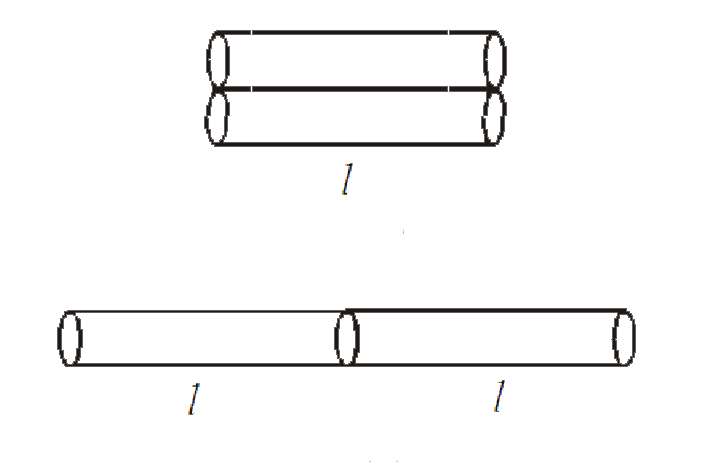 03:28View Solution
03:28View SolutionThe energy emitted per second by a black body at `27^(@)C` is 10 J. If the temperature of the black body is increased to `327^(@)C` , the energy emitted per second will be
01:50View SolutionThe dimensional forumla for thermal resistance is
01:39View SolutionTwo vessels of different materials are similar in size in every respect. The same quantity of ice filled in them gets melted in 20 minutes and 30 minutes. The ratio of their thermal conductivities will be
03:13View SolutionThe temperature of a body is increased by `50%`. The amount of radiation emitted by it would be nearly
01:36View SolutionA cylinder of radius R made of material of thermal conductivity `K_(1)` is surrounded by a cylindrical shell of inner radius R and outer radius 3R made of a material of thermal conductivity `K_(2)`. The two ends of the combined system are maintained at two different temperatures. What is the effective thermal conductivity of the system ?
04:23View SolutionThe temperature of a body in increased from `27^(@)C` to `127^(@)C`. By what factor would the radiation emitted by it increase?
01:35View SolutionA metal ball of surface area `200 cm^(2)` and temperature `527^(@)C` is surrounded by a vessel at `27^(@)C` . If the emissivity of the metal is 0.4, then the rate of loss of heat from the ball is `(sigma = 5.67 xx10^(-8)J//m^(2)-s-k^(4))`
02:59View SolutionA spherical black body with a radius of 12 cm radiates 450 W power at 500 K. If the radius were halved and the temperature doubled, the power radiated in watt would be
(a)225 (b)450
(c) 900 (d)180002:38View SolutionWires A and B have have identical lengths and have circular cross-sections. The radius of A is twice the radius of B i.e. `R_A = 2R_B`. For a given temperature difference between the two ends, both wires conduct heat at the same rate. The relation between the thermal conductivities is given by-
02:22View SolutionThe ratio of thermal conductivity of two rods of different material is `5 : 4`. The two rods of same area of cross-section and same thermal resistance will have the lengths in the ratio
02:02View SolutionThe height of a waterfall is 84 metre . Assuming that the entire kinetic energy of falling water is converted into heat, the rise in temperature of the water will be (`g=9.8 m//s^(2),J=4.2` joule / cal)
02:10View SolutionIn a steady state of thermal conduction, temperature of the ends A and B of a 20 cm long rod are `100^(@)C` and `0^(@)C` respectively. What will be the temperature of the rod at a point at a distance of 6 cm from the end A of the rod
02:55View SolutionA black metal foil is warmed by radiation from a small sphere at temperature `T` and at a distance d it is found that the power received by the foil is `P` If both the temperature and the distance are doubled the power received by the foil will be .
02:54View SolutionA heat flux of 4000 J/s is to be passed through a copper rod of length 10 cm and area of cross section `100cm^2`. The thermal conductivity of copper is `400W//m//^(@)C` The two ends of this rod must be kept at a temperature difference of
02:39View SolutionThe temperature of a liquid drops from 365 K to 361 K in 2 minutes . Find the time during which temperature of the liquid drops from 344 K to 342 K.Temperature of room is 293 K
02:31View SolutionConsider two hot bodies `B_(1)` and `B_(2)` which have temperature `100^(@)"C"` and `80^(@)"C"` respectively at t = 0. The temperature of surroundings is `40^(@)" C"`. The ratio of the respective rates of cooling `R_(1)` and `R_(2)` of these two bodies at` t = 0` will be
02:19View SolutionThe temperature of a perfect black body is `727^(@)C` and its area is `0.1 m^(2)`. If Stefan's constant is `5.67 xx 10^(-8) watt//m^(2)-s-K^(4)`, then heat radiated by it in 1 minute is:
02:32View SolutionThe temperature of a piece of metal is raised from `27^(@)C` to `51.2^(@)C`. The rate at which the metal radiates energy increases nearly,
03:32View SolutionThe dimensions of coefficient of thermal conductivity is
03:00View Solution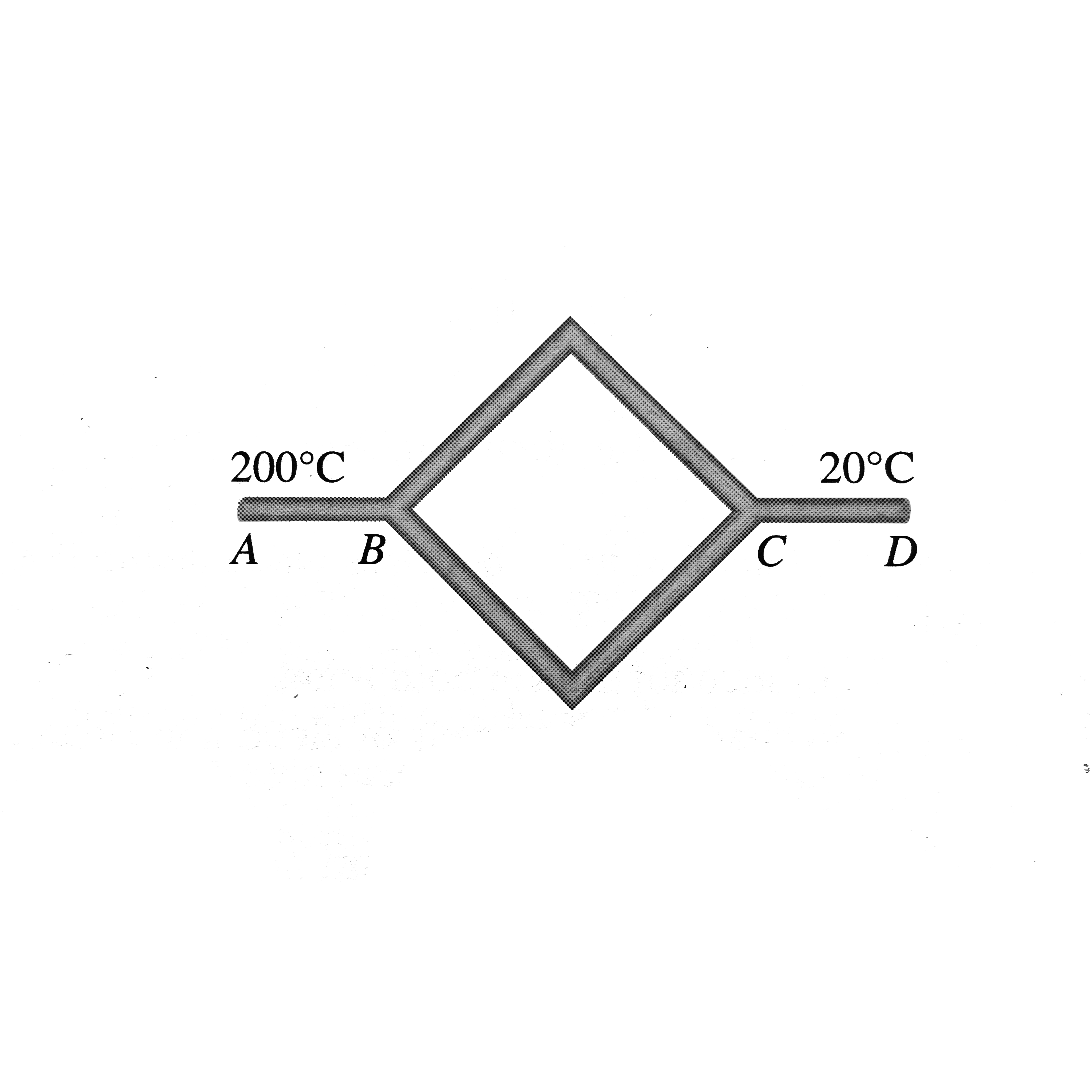
Six identical cunducting rods are joined as shown in Fig. Points A and D are maintained at temperatures `200^@C` and `20^@C` respectively. The temperature of junction B will be03:05View SolutionTwo rods A and B of different materials are welded together as shown in figure. Their thermal conductivities are `K_(1)` and `K_(2)`. The thermal conductivity of the composite rod will be
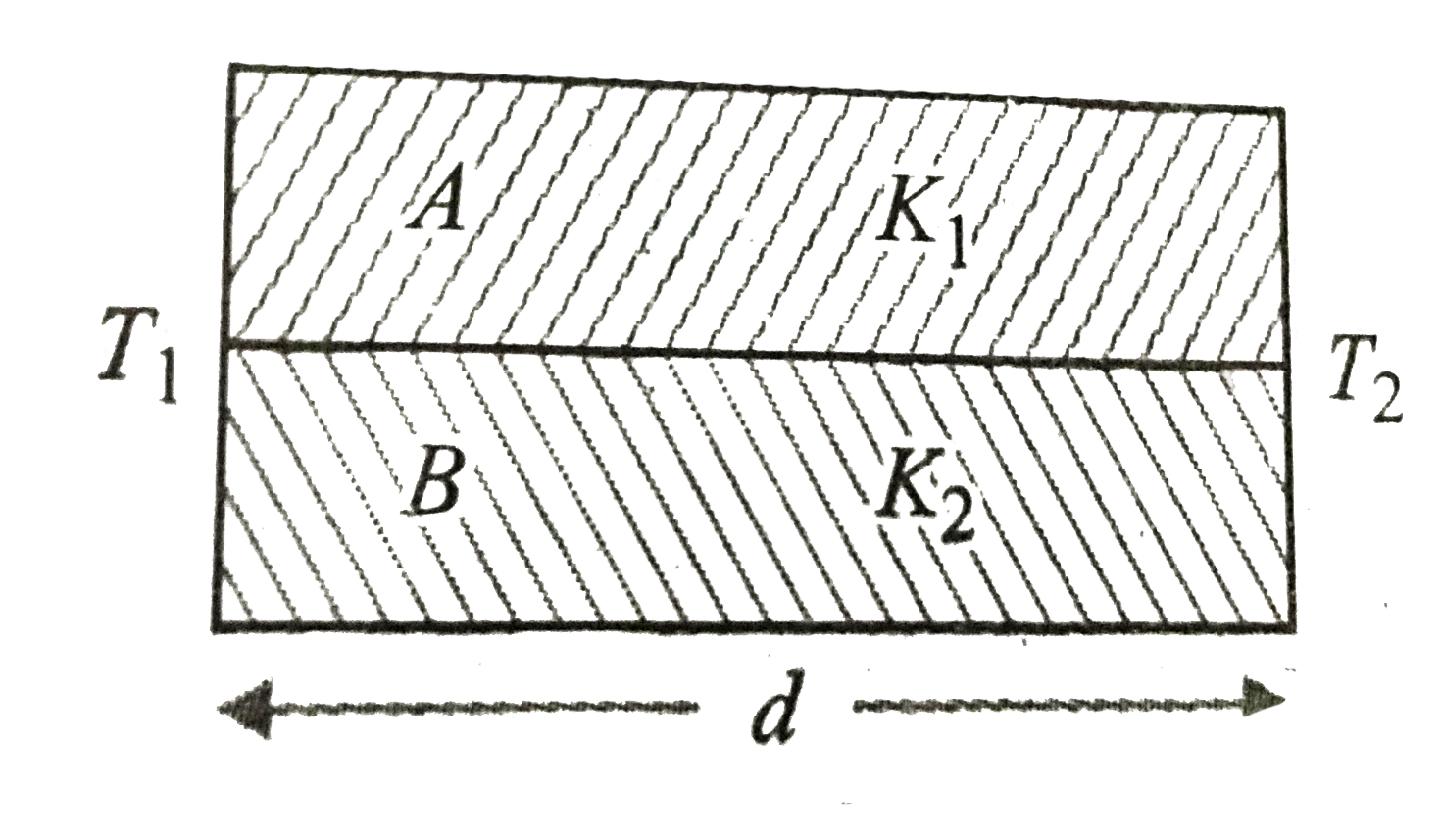 01:37View Solution
01:37View SolutionA parallel-sided slab is made of two different materials. The upper half of the slab is made of material X, of thermal conductivity `lambda`, the lower half is made of material Y, of thermal conductivity `2 lambda`. In the steady state, the left hand face of the composite slab is at a higher, uniform temperature than the right-hand face, and the flow of heat through the slab is parallel to its shortest sides. What fraction of the total heat flow through the slab passes through material X ?
View SolutionMetal rods X and Y of identical cross-sectional area, have lengths 60 cm and 30 cm respectively. They are made of metals of thermal conductivities `lambda_(x)` and `lambda_(y)`. They are well-lagged and joined end-to-end as shown in the figure-4.43. One end of X is maintained at `100^(@)C` and the opposite end of Y is maintained at `0^(@)C`. When steady conditions have been .reached, the temperature of the junction is found to be `25^(@)C`.
What is the value of `(lambda_(x))/(lambda_(y))` ?
 04:31View Solution
04:31View SolutionWhen the centre of earth is at a distance of `1.5 xx 10^(11)m` from the centre of sun, the intensity of solar radiation reaching at the earth's surface is `1.26kW//m^(2)`. There is a spherical cloud of cosmic dust, containing iron particles. The melting point for iron particles in the cloud is 2000 K. Find the distance of iron particles from the centre of sun at which the iron particle starts melting. (Assume sun and cloud as a black body, `sigma = 5.8 xx 10^(-8) W//m^(2)K^(4))`:
05:46View SolutionRead the passage carefully and answer the followingquestions.
Imagine a system, that can keep the room temperature within a narrow range between `20^(@)C` to `25^(@)C`. the system includes a heat engine operating with variable power `P =KT`, where K is a constant coefficient, depending upon the thermal insulation of the room, the area of the walls and the thickness of the walls. T is temperature of the room in degree, when the room temperature drops lower than `20^(@)C`, the engine turns on,when the temperature increase over `25^(@)C`, theengineturnsoff, room looses energy at a ate of `K(T-T_(0)` is the outdoor temperature. Thde heat capacity of the room is C.
Given `(T_(0)=10^(@)C,In((3)/(2))=0.4,In((6)/(5))=0.18,(C)/(K)=750SI-unit)`
Suppose at t = 0, the engine turns off, after how much time interval, again, the engine will turn on:View SolutionTwo balls of same material and finish have their diameters in the ratio 2:1. Both are heated to the same temperature and allowed to cool by radiation. Rate of cooling of big ball as compared to smaller one will be in the ratio:
02:55View SolutionThree bars each of area of cross section A and length L are connected in series as shown in the figure. Thermal conductivities of their materials are K, 2K and 1.5K. If the temperatures of free end of first and the last bar are `200^(@)C` and `18^(@)C`. The value of `theta_(1)` and `theta_(2)` are (in steady state):
View SolutionFour identical rods which have thermally insulated lateral surface are joined at point O. Points A,B,C and D are connected to furnace maintained at constant tempertures. If the heat flows into the junction O from A at the rate of 2J/s and from B at 4J/s and flows out towards C is 8J/s. Chosse the correct relation.
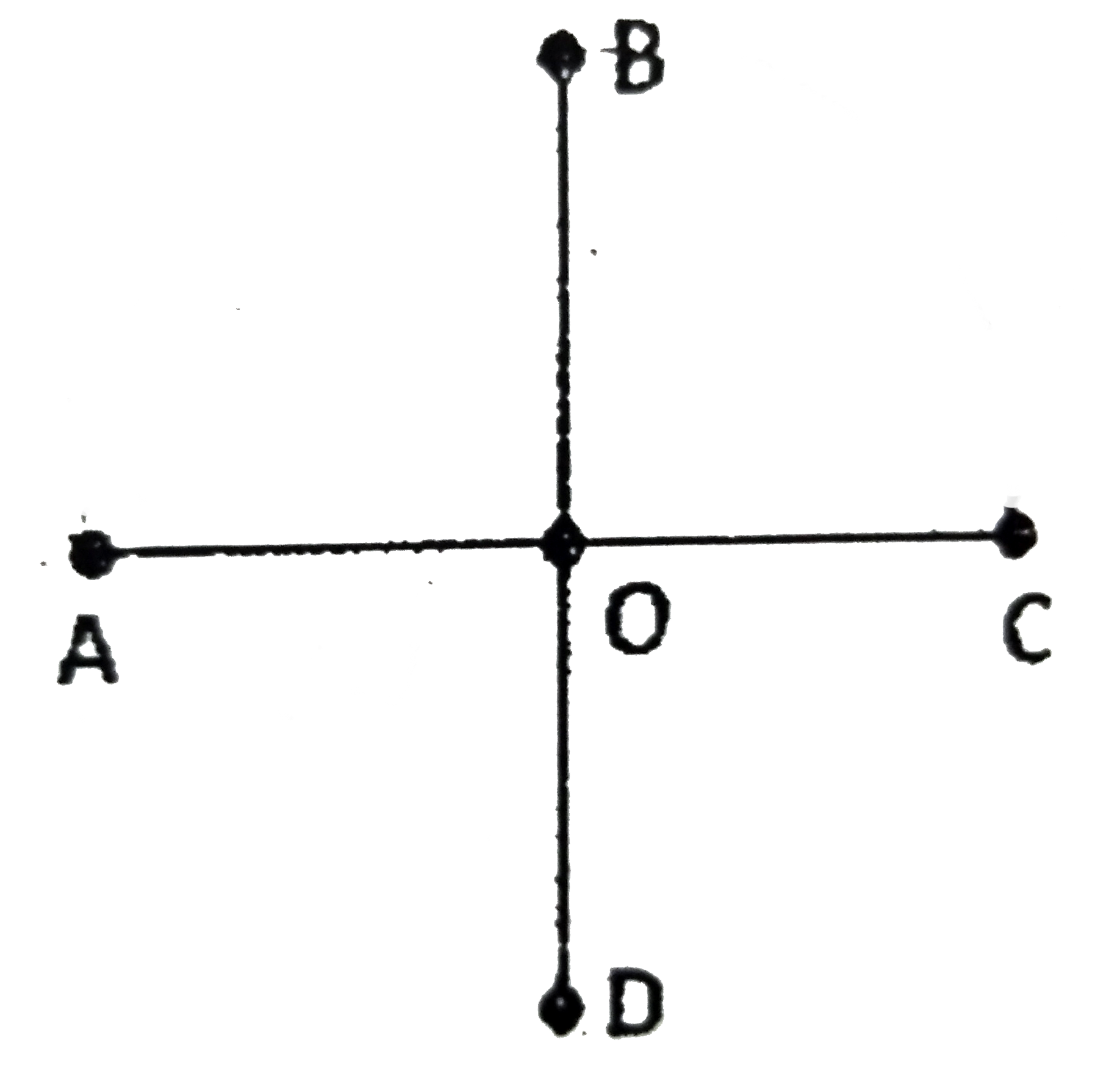 06:28View Solution
06:28View SolutionIn a room where the temperature is `30^(@)C`, a body cools from `61^(@)C` to `59^(@)C` in 4 minutes. The time (in min.) taken by the body to cool from `51^(@)C` to `49^(@)C` will be
05:04View SolutionTwo identical conducting rods AB and CD are connected to a circular conducting ring at two diametrically opposite points B and C, the radius of the ring is equal to the length of rods AB and CD. The area of cross-section, thermal conductivity of the rod and ring are equal. points A and D are maintained at temperatures of `100^(@)C` and `0^(@)C`. temperature at poimt C will be
 04:03View Solution
04:03View Solution
Numerical MCQs Single Options Correct questions and complete solutions for chapter HEAT TRANSFER of GK PUBLICATIONS PHYSICS (HINGLISH) of Class 12
All Exercises from PHYSICS GALAXY Class 12 PHYSICS HEAT TRANSFER
- Advance MCQs with One or More Option Correct
- Conceptual MCQs Single Option Correct
- Discussion Question
- Illustrative Example 4.1
- Illustrative Example 4.10
- Illustrative Example 4.11
- Illustrative Example 4.12
- Illustrative Example 4.13
- Illustrative Example 4.14
- Illustrative Example 4.15
- Illustrative Example 4.16
- Illustrative Example 4.17
- Illustrative Example 4.18
- Illustrative Example 4.19
- Illustrative Example 4.2
- Illustrative Example 4.20
- Illustrative Example 4.21
- Illustrative Example 4.22
- Illustrative Example 4.23
- Illustrative Example 4.24
- Illustrative Example 4.25
- Illustrative Example 4.26
- Illustrative Example 4.27
- Illustrative Example 4.28
- Illustrative Example 4.29
- Illustrative Example 4.3
- Illustrative Example 4.4
- Illustrative Example 4.5
- Illustrative Example 4.6
- Illustrative Example 4.7
- Illustrative Example 4.8
- Illustrative Example 4.9
- Numerical MCQs Single Options Correct
- Practice Exercise 4.1
- Practice Exercise 4.2
- Practice Exercise 4.3
- Practice Exercise 4.4
- Unsolved Numerical Problems for Preparation of NSEP,INPhO&IPhO
